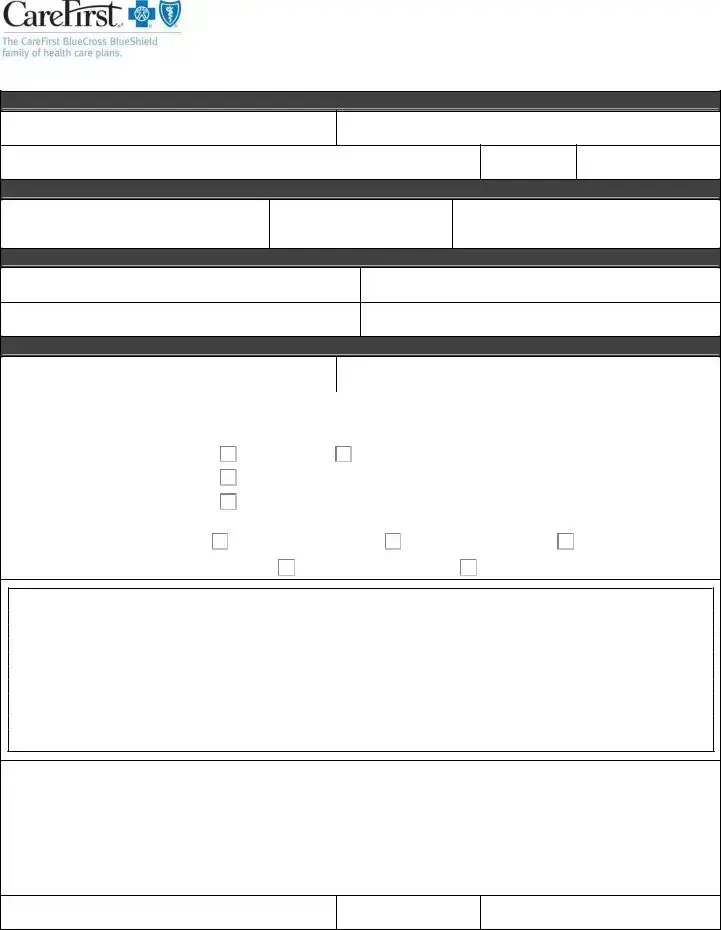The Direct Deposit Authorization Form is quite similar to the CareFirst EFT Form. Both forms are designed to collect necessary banking details to set up electronic funds transfers directly into an account. They require the account holder's name, the financial institution's name and address, the bank routing number, and the account number. The main goal is to streamline payment processes, ensuring timely and direct deposit of funds into the account specified by the account holder.
Another document that shares similarities with the CareFirst EFT Form is the Payroll Direct Deposit Form often used by employers. This form collects employee banking information to deposit salaries directly into their bank accounts. Like the EFT Form, it requires identification of the account type (checking or savings), account and routing numbers, and often a voided check or bank letter to verify the account details. Both forms aim to make the transfer of funds more efficient and reduce the reliance on physical checks.
The Vendor Direct Deposit Authorization is also akin to the CareFirst EFT Form. Vendors provide their banking information on this form to receive payments for goods or services electronically. This form, like the CareFirst version, helps in speeding up the payment process, improving cash flow management for both parties by reducing the delay experienced with traditional cheque payments.
The Health Insurance Payment Authorization Form is another document that shares functionality with the CareFirst EFT Form. It authorizes insurance companies to deposit claim payments directly into the healthcare provider’s or policyholder's bank account. The necessity for accurate provider or policy holder's bank details, including the financial institution’s routing number and the account number, draws a direct parallel to the information requested in CareFirst’s form.
The Tax Refund Direct Deposit Authorization form is designed for taxpayers to receive their state or federal tax refunds electronically. Similar to the CareFirst EFT Form, it requests the taxpayer's banking information, ensuring a direct and secure transfer of their refund into their preferred bank account, which speeds up the refund process considerably compared to traditional mail checks.
An Electronic Rent Payment Authorization form allows tenants to set up automatic rent payments from their bank account. The form collects tenant banking information to automatically transfer rent payments to the landlord’s account. Both this form and the CareFirst EFT Form facilitate regular, scheduled payments, ensuring timely transactions without the physical exchange of cheques or cash.
The Automatic Loan Payment Authorization form is tailored for individuals who wish to automate the repayment of loans. Borrowers submit their banking details through this form, authorizing the lender to deduct loan payments directly from their bank account, similar to how the CareFirst EFT Form sets up for automatic deposits, streamlining the payment process and avoiding late payments.
A Utility Bill Direct Debit Authorization is yet another document sharing similarities with the CareFirst EFT Form. It is used by consumers to set up automatic payments for their utility bills, providing bank account information for this purpose. This form makes the payment of regular bills more convenient by automating the deduction process, paralleling the way the CareFirst form facilitates automatic insurance payment deposits.
The Student Loan Disbursement Authorization form is designed for students or their parents to receive loan amounts directly into a specified bank account. Like the CareFirst EFT Form, it gathers the bank account details necessary for the electronic transfer of funds, ensuring that the borrower receives their funds efficiently for educational expenses.
Lastly, the Investment Dividends Direct Deposit Form is used by investors to have their dividends deposited directly into a bank account. This form collects similar information as the CareFirst EFT Form, such as the investor's bank account and routing numbers, to facilitate the electronic transfer of dividends, highlighting the convenience and efficiency of receiving payments electronically.



